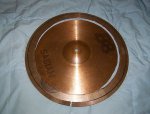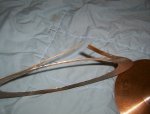Concrete Pete
Senior Member
Hey Crew,
As you all know, (from my previous posts) I'm on a major quest to learn all I can about cymbal repair, customization, and maybe even (someday) learn how to completely AND permanently repair cracked cymbals to their original (or nearly original) state and possibly even the original sound. (the sound restoration is probably a pipe dream)
That in mind, I was fortunate enough to get a BUNCH of cracked and damaged (various brands and sizes) cymbals after posting an ad on Craigslist- one of them was a 20"/51cm Sabian B8 ride with a HELLUVA perimeter crack that splayed up two "wing" type protrusions from the damage. (this will be a long post, so bear with)
Since the cymbal was really thick, cutting it down with metal shears was impossible. I fabbed up a makeshift jig that allowed the cymbal to rotate as it was being cut with an angle grinder with a diamond blade to keep the perimeter dimensions true. One cut to make a kerf, and another pass to do the full-depth cut. (see the pics) After cutting 2" off of the perimeter, I did a 6-way grind on the edge- a 90, then two 45's, then two 30 degree grinds, followed by a belt sander rounding (at about 22 degrees) to true the cut perimeter edge, and match the original cymbal edge rounding angles. (kind of like lapping and facing valves for an engine)
After that, I used Jasco Gel paint stripper to both remove the Sabian logos, and (partially) remove some of the dark spots and patina flaws that were in the cymbal's finish. (left it on for EXACTLY 6.5 minutes) Followed that up with 00 steel wool dressing, a good warm water wash with Ajax dish detergent, and then two hand-rubbed polishings with Trick brand drum/cymbal polish. (You''l see in the attached pics that the Sabian logo left a "ghost" imprint/shine.)
This process left me with about 3.8 ounces of B-20 bronze to UPS to my bro Jeff at OceanFront Engineering for metallurgy and research on the metal, and another ounce or 2 for me to experiment on with brazing/heat treating/ soldering/ torch/ and heat treating in my humble garage. Also left me with almost a 1/2 ounce of B-20 metal shavings/dust to experiment with as an alloy, or as a surface additive for brazing and welding.
I've spent upwards of 1K on the metallurgical stuff so far, and hope my costs will not go too much higher than that. Just wish me "luck" or "good fortune" on all of this. I almost feel like I'm searching for the cure for cancer, or something--it's out there, just needs to be discovered.
Man, I really hope I get some concrete results (eventually) after all this work.
Cheers,
C. P.
As you all know, (from my previous posts) I'm on a major quest to learn all I can about cymbal repair, customization, and maybe even (someday) learn how to completely AND permanently repair cracked cymbals to their original (or nearly original) state and possibly even the original sound. (the sound restoration is probably a pipe dream)
That in mind, I was fortunate enough to get a BUNCH of cracked and damaged (various brands and sizes) cymbals after posting an ad on Craigslist- one of them was a 20"/51cm Sabian B8 ride with a HELLUVA perimeter crack that splayed up two "wing" type protrusions from the damage. (this will be a long post, so bear with)
Since the cymbal was really thick, cutting it down with metal shears was impossible. I fabbed up a makeshift jig that allowed the cymbal to rotate as it was being cut with an angle grinder with a diamond blade to keep the perimeter dimensions true. One cut to make a kerf, and another pass to do the full-depth cut. (see the pics) After cutting 2" off of the perimeter, I did a 6-way grind on the edge- a 90, then two 45's, then two 30 degree grinds, followed by a belt sander rounding (at about 22 degrees) to true the cut perimeter edge, and match the original cymbal edge rounding angles. (kind of like lapping and facing valves for an engine)
After that, I used Jasco Gel paint stripper to both remove the Sabian logos, and (partially) remove some of the dark spots and patina flaws that were in the cymbal's finish. (left it on for EXACTLY 6.5 minutes) Followed that up with 00 steel wool dressing, a good warm water wash with Ajax dish detergent, and then two hand-rubbed polishings with Trick brand drum/cymbal polish. (You''l see in the attached pics that the Sabian logo left a "ghost" imprint/shine.)
This process left me with about 3.8 ounces of B-20 bronze to UPS to my bro Jeff at OceanFront Engineering for metallurgy and research on the metal, and another ounce or 2 for me to experiment on with brazing/heat treating/ soldering/ torch/ and heat treating in my humble garage. Also left me with almost a 1/2 ounce of B-20 metal shavings/dust to experiment with as an alloy, or as a surface additive for brazing and welding.
I've spent upwards of 1K on the metallurgical stuff so far, and hope my costs will not go too much higher than that. Just wish me "luck" or "good fortune" on all of this. I almost feel like I'm searching for the cure for cancer, or something--it's out there, just needs to be discovered.
Man, I really hope I get some concrete results (eventually) after all this work.
Cheers,
C. P.






